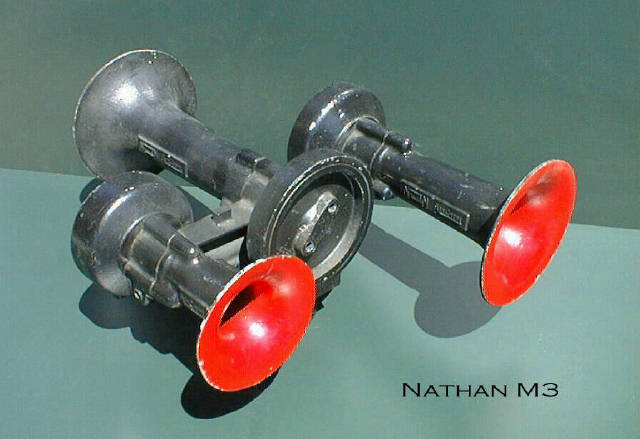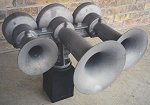Nathan M3 | |
|---|---|
 | |
The picture illustrates a common arrangement of the bells with the #1 bell reversed (turned backward). In this configuration, the horn is designated an M3R1. | |
 | Side view of the M3R1. |
 |
|
 |
|
Factory tuning for the M3 was: A major triad (C#,E,A). | |
The M3 suffered the maintenance problems common to all M-series
horns. Once very popular, few new M3's have been made since the early 1980's, and the horns
are rare to find in use today. Willamette & Pacific applied old M3's to most of their
locomotives in the 1990's, and a few shortlines still have locomotives with M3's. A scattered
handful of M3's survive on Union Pacific, mostly on former Rio Grande power. | |
M3 sound samples:Modesto & Empire Traction GE 70-ton:Sample 1...306kB...14 seconds Sample 2...402kB...18 seconds Sample 3...221kB...10 seconds Niles Canyon Railway GE 80-ton (horn courtesy 5CC): Sample 1...92kB...4 seconds Sample 2...108kB...5 seconds Sample 3...229kB...10 seconds Sample 4...212kB...9 seconds Sample 5...286kB...13 seconds Pandrol Jackson railgrinder: Sample 1...237kB...11 seconds Willamette & Pacific GP39-2: Sample 1...304kB...14 seconds When bad things happen to good horns:The M-series horns were supposed to be tuned and voiced every six months or so to keep them sounding properly. Otherwise, the horns soon went out of tune. Sometimes M3's managed to sound good, if different, despite deferred maintenance. Other times they did not:Modesto & Empire Traction GE 70-ton: Sample 1...194kB...9 seconds Willamette & Pacific GP39-2: Sample 2...361kB...16 seconds Sample 3...471kB...21 seconds | |